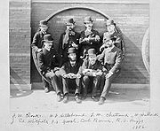
Frank Austen Gooch
Encyclopedia

Chemist
A chemist is a scientist trained in the study of chemistry. Chemists study the composition of matter and its properties such as density and acidity. Chemists carefully describe the properties they study in terms of quantities, with detail on the level of molecules and their component atoms...
and engineer
Engineer
An engineer is a professional practitioner of engineering, concerned with applying scientific knowledge, mathematics and ingenuity to develop solutions for technical problems. Engineers design materials, structures, machines and systems while considering the limitations imposed by practicality,...
. He was born to Joshua G. & Sarah Gates (Coolidge) Gooch in Watertown, Massachusetts
Watertown, Massachusetts
The Town of Watertown is a city in Middlesex County, Massachusetts, United States. The population was 31,915 at the 2010 census.- History :Archeological evidence suggests that Watertown was inhabited for thousands of years before the arrival of settlers from England...
. On his mother's side of the family, he was a descendant of Thomas Hastings (colonist)
Thomas Hastings (colonist)
Thomas Hastings was a prominent English immigrant to New England, one of the approximately 20,000 immigrants who came as part of the Great Migration. A Deacon of the church, among his many public offices he served on the Committee of Colony Assessments in 1640 and as Deputy for Watertown to the...
who came from the East Anglia
East Anglia
East Anglia is a traditional name for a region of eastern England, named after an ancient Anglo-Saxon kingdom, the Kingdom of the East Angles. The Angles took their name from their homeland Angeln, in northern Germany. East Anglia initially consisted of Norfolk and Suffolk, but upon the marriage of...
region of England to the Massachusetts Bay Colony
Massachusetts Bay Colony
The Massachusetts Bay Colony was an English settlement on the east coast of North America in the 17th century, in New England, situated around the present-day cities of Salem and Boston. The territory administered by the colony included much of present-day central New England, including portions...
in 1634.
Gooch invented the Gooch crucible
Gooch crucible
A Gooch crucible, named after Frank Austen Gooch, is a filtration device for laboratory use . It is convenient for collecting a precipitate directly within the vessel in which it is to be dried, possibly ashed, and finally to be weighed in gravimetric analysis.The device was originally a standard...
, which is used, for example, to determine the solubility of bituminous materials such as road tars and petroleum asphalts. He was awarded a Ph.D. by Harvard University
Harvard University
Harvard University is a private Ivy League university located in Cambridge, Massachusetts, United States, established in 1636 by the Massachusetts legislature. Harvard is the oldest institution of higher learning in the United States and the first corporation chartered in the country...
in 1877. Gooch was a Professor of Chemistry at Yale University
Yale University
Yale University is a private, Ivy League university located in New Haven, Connecticut, United States. Founded in 1701 in the Colony of Connecticut, the university is the third-oldest institution of higher education in the United States...
from 1885 to 1918.
He devised or perfected a large number of analytical processes and methods, including:
- Invented the Gooch filtering crucibleCrucibleA crucible is a container used for metal, glass, and pigment production as well as a number of modern laboratory processes, which can withstand temperatures high enough to melt or otherwise alter its contents...
. - Studied the quantitative separation of lithium from the other alkali metals, and the estimation of boric acid by distillation with methanol and fixation by calcium oxide.
- Developed methods for estimating molybdenum, vanadium, selenium, and tellurium.
- Studied the use of the paratungstate and pyrophosphate ions in analysis.
- Developed a series of methods for estimating various elements based on the volumetric determination of iodine.
- Discovered a method for the rapid electrolytic estimation of metals.
Further reading
- Biog. Mem. Nat. Acad. Sci. 1931, 15, 105-135.
- Ind. Eng. Chem. 1923, 15, 1088-1089.
- Proc. Am. Acad. Arts Sci. 1935-36, 70, 541.
- Am. J. Sci. (Ser. 5) 1929, 18, 539-540.
- National Cyclopaedia of American Biography, James T. White & Co.: 1921-1984; vol. 12, p329-330.
External links
- Frank Austen Gooch (biography at University of Illinois)
- Descendants of Thomas Hastings website
- Descendants of Thomas Hastings on Facebook

